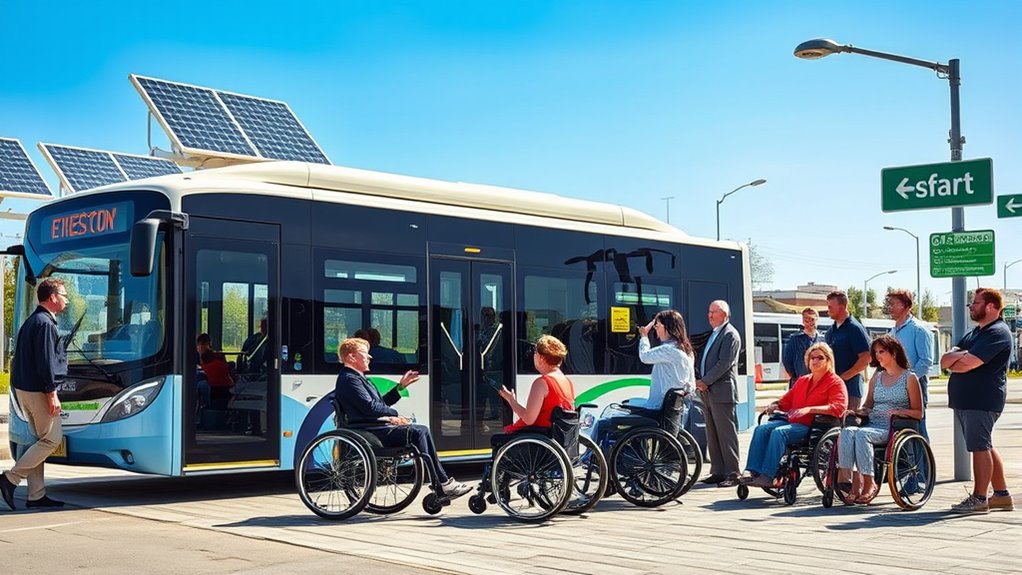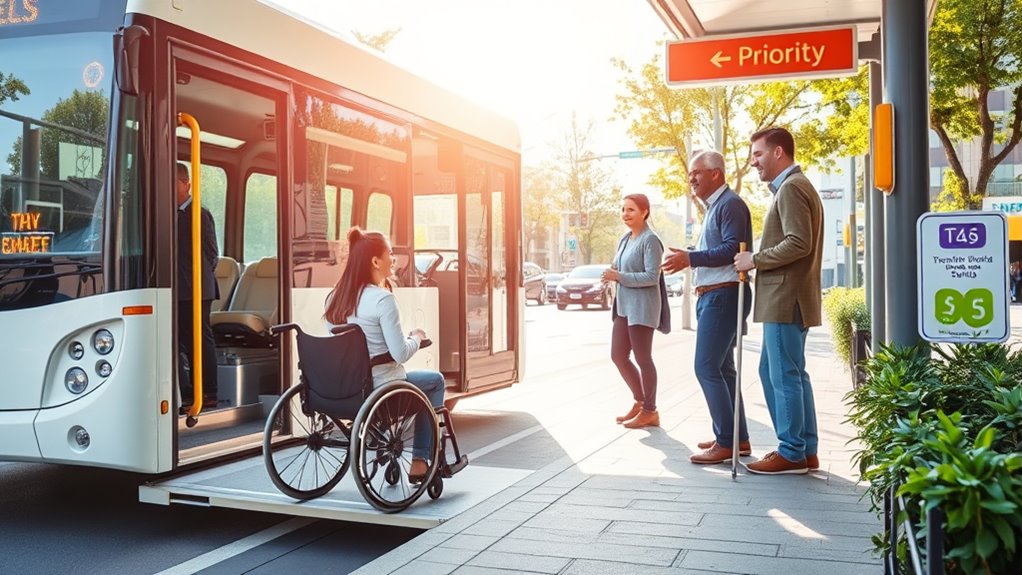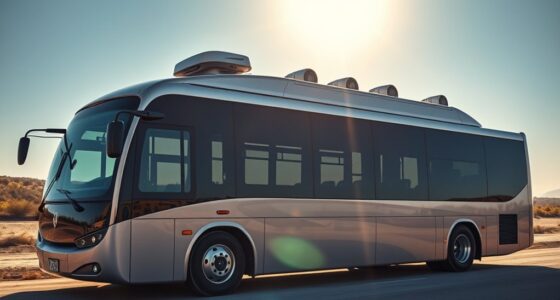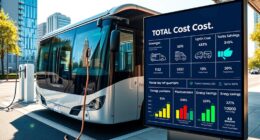Accessible electric buses are improving for disabled users by offering features like low floors, dedicated wheelchair spaces, and automatic ramps. However, challenges remain, such as malfunctioning ramps, crowded interiors, and limited space for mobility devices. These issues can cause delays and frustration, but ongoing upgrades and user feedback are helping to address them. Keep exploring to discover how these buses are evolving to better serve everyone’s needs.
Key Takeaways
- Not all electric buses have comprehensive accessibility features, leading to inconsistent user experiences for disabled passengers.
- Automatic ramps can malfunction or be slow, causing delays and frustration for wheelchair users.
- Interior layouts and narrow aisles can obstruct maneuvering and reduce independence during boarding and alighting.
- Design issues, such as poorly placed wheelchair spaces or blocked securement areas, hinder accessibility in crowded conditions.
- Rider feedback highlights the need for more reliable, intuitive systems and continuous upgrades to enhance inclusivity.

Electric buses are transforming public transportation by offering a cleaner and more sustainable alternative to traditional diesel models. As a user with a disability, you’ve probably noticed that these buses are designed with accessibility in mind, but there’s still room for improvement. One of the biggest benefits is the enhanced boarding ease. Electric buses often feature low floors, which means you don’t have to struggle with high steps or awkward ramps. Instead, you can simply walk or roll straight onto the bus, making your commute smoother and less stressful. This lowered entry point is especially helpful if you use a wheelchair, walker, or have difficulty climbing stairs. It shortens your wait time and reduces the physical effort needed to board, giving you more independence and control over your journey.
Wheelchair access on electric buses has seen significant advancements, but it’s not perfect yet. Many models include dedicated spaces for wheelchairs, with securement systems that keep your mobility device stable during transit. These spaces are often located near the doors for easy entry and exit, which is vital if you’re in a hurry or have limited mobility. Some buses even have automatic ramps or lifts, making it easier for you to get on and off without assistance. However, challenges still remain. Not all electric buses are equipped with these features, and in some cases, the ramps can be slow or difficult to deploy, especially during busy times or in adverse weather conditions. Additionally, the interior layout isn’t always optimized for wheelchair users, with narrow aisles or obstructed pathways that can make maneuvering cumbersome.
You might also encounter issues with the reliability of these accessibility features. For instance, automatic ramps sometimes malfunction or require manual operation, which can cause delays or embarrassment. The placement of designated wheelchair spaces might not always be ideal, especially if the bus is crowded or the space is blocked by other passengers’ belongings. While electric buses are a step forward, they still need ongoing upgrades and maintenance to guarantee full accessibility for all users. You deserve a transit experience that is not only eco-friendly but also inclusive. Continuous improvements, such as more intuitive boarding systems, better interior layouts, and reliable accessibility features, are essential. As a rider, your feedback plays an important role in pushing transit authorities to prioritize these enhancements, ensuring electric buses truly serve everyone’s needs.
Frequently Asked Questions
How Do Electric Buses Impact Overall Accessibility for Disabled Passengers?
Electric buses improve accessibility for disabled passengers by offering smoother rides and quieter operation. However, your experience depends on battery life and charging infrastructure. If the battery lasts longer, you won’t face frequent delays, and better charging stations mean quicker, more reliable access. As these systems improve, disabled users will find electric buses more dependable, making travel easier and more comfortable, ultimately enhancing public transit inclusivity.
What Specific Features Make Electric Buses More Accessible Than Traditional Buses?
Think of electric buses as open doors to inclusivity. You’ll notice automatic ramps that smoothly deploy, symbolizing ease of access, and clear visual displays that serve as guiding lights for all. These features make the ride more accessible, ensuring disabled passengers can navigate effortlessly. By combining modern technology with thoughtful design, electric buses become symbols of progress, making transportation fairer and more welcoming for everyone.
Are There Any Additional Costs for Accessible Electric Bus Modifications?
Yes, there are additional costs for accessible electric bus modifications. You might face a cost increase due to retrofit expenses needed to add features like ramps, low floors, and accessible seating. These upgrades ensure conformity with accessibility standards, but they can raise the overall expense. While initial investments are higher, the long-term benefits of electric buses, such as reduced emissions and lower operating costs, often outweigh these retrofit expenses.
How Do Maintenance Needs Differ for Accessible Electric Versus Diesel Buses?
Maintaining accessible electric buses differs markedly from diesel ones. You’ll spend less on engine repairs but need to focus on charging infrastructure upkeep and battery replacement. Electric buses require regular monitoring of batteries and charging systems, unlike diesel engines that need mechanical tune-ups. While electric buses have fewer moving parts, you must plan for specialized maintenance of electrical components, ensuring safety and efficiency in operation.
What Are the Future Plans for Expanding Accessible Electric Bus Fleets?
You can expect government funding to increasingly support the expansion of accessible electric bus fleets, aiming to improve mobility for all. Technological innovations, like advanced battery systems and improved accessibility features, will drive these efforts. Cities and transit agencies plan to deploy more of these buses in the coming years, making public transportation more inclusive. Your community will likely see greater investment and smarter solutions, ensuring accessible electric buses become a standard part of transit systems nationwide.
Conclusion
As you ride an accessible electric bus, imagine the seamless glide over smooth roads, the gentle hum of quiet engines, and the welcoming space that welcomes everyone. Picture disabled users confidently stepping on, feeling the support and independence they deserve. With each improvement, we build a future where transportation flows effortlessly like a steady stream, embracing diversity and inclusion. Together, we can make every journey smoother, brighter, and more accessible for all who travel.









